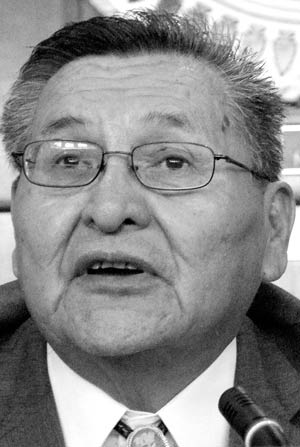Shelly: Tribe will need all energy sources
By Noel Lyn Smith
Navajo Times
WINDOW ROCK, April 18, 2013

CRED
President Ben Shelly
T he tribe's future could be determined by continuing to tap into its natural resources while transitioning from the current state of coal usage.
That is the message Navajo Nation President Ben Shelly delivered in the state of the nation address, all in the Diné language, to the Navajo Nation Council Monday on the first day of the spring session.
"We must explore our possibilities for both sectors of energy," Shelly said. "We can use them to prosper the Navajo Nation. Our wealth in natural resources can create economic wealth for the Navajo Nation."
One way the tribe is exploring the new level of energy development is through partnerships with the Lawrence Livermore and Sandia national laboratories.
Shelly reported that Lawrence Livermore National Laboratory is continuing to complete a comprehensive energy assessment of the tribe's natural resources and Sandia National Laboratories is developing models to examine how future energy projects could impact the environment and climate.
"From there, we can construct viable and realistic plans that will bring the Navajo Nation into a new dimension of energy production," the president said.
Another outlet for the tribe to tap into its natural resources is to update the tribe's energy policy, which was initially approved in 1980, and has the potential to set standards for energy purchases, development and management.
Shelly said the amended policy was submitted last year to the Council's Resources and Development Committee but no action has been taken on it.
"We need to make necessary changes to the policy and get it through Council so we can better protect our resources as we are walking into the future," he said.
As for the possible purchase of Navajo Mine from its owners BHP Navajo Coal Co., the president said the due diligence process continues but at stake is $100 million in revenue per year for the tribe and hundreds of jobs at the mine and the Four Corners Power Plant.
He mentioned that the coal sale agreement from 2016 to 2031, the stock purchase agreement and a promissory note are at the negotiating table.
Keeping in line with the coal talk, Shelly also reminded the Council of the importance of preserving jobs at Navajo Generating Station and its coal supplier Kayenta Mine.
"As a government, it is our responsibility to protect the quality of life of Diné citizens," Shelly said. "We must approve this lease extension because we have families who depend on the wages earned at these jobs."
He did not mention how the tribe's possible new approach to coal production would factor into these two established mines.
Speaker Johnny Naize (Blue Gap-Tachee/Cottonwood-Tselani/Low Mountain/Many Farms/Nazlini) is sponsoring the bill to extend the NGS lease from 2019 to 2044. The Council was expected to consider it Wednesday.
Shelly mentioned the fiscal year 2014 federal budget that President Barack Obama submitted to Congress last week, noting that the budget has proposed reductions of 40 percent to the U.S. Department of Justice, 9 percent to the U.S. Department of Agriculture and the U.S. Department of Housing and Urban Development, and 8 percent to the U.S. Department of Labor.
Despite those cuts, Obama asked for a 3.5 percent increase for Indian Health Services. The budget does not include the anticipated cuts of 5 to 8.2 percent from the sequester.
Due to the financial impact of the sequester, Shelly reminded the Council that it is important to save $20 million in the Undesignated Unreserved Fund Balance. Last year the three branch chiefs agreed to preserve that amount in anticipation of cuts at the federal level.
The president was pleased to announce the Twin Arrows Navajo Casino Resort would around May 23.
Once the facility, located approximately 20 miles east of Flagstaff, opens, Shelly plans to issue an executive order to tribal divisions and departments to conduct meetings and conferences at the facility.
This action would enforce the idea that Navajo can support its own, he said.
He commended the work completed by the tribe's Department of Emergency Management and its director Rose Whitehair for providing relief when water pipelines and systems froze earlier in the year.
Since taking office last year, Whitehair discovered $7 million in federal grants that have not been distributed and could be returned to the Federal Emergency Management Agency if not spent, the president said.
As a solution, Shelly directed his Chief of Staff Arbin Mitchell to assign two executive staff members to assist the emergency management department.
"We cannot afford to return any more money to the federal government especially when these funds will benefit chapters," he said.
Another natural disaster that has impacted the tribe is the closure of U.S. Highway 89 south of Page, Ariz. due to a landslide in February.
Since the closure the Navajo Division of Transportation has been working with the Arizona Department of Transportation, Coconino County and local chapters to complete road maintenance on Navajo Route 20 to provide an alternate route for travel.

